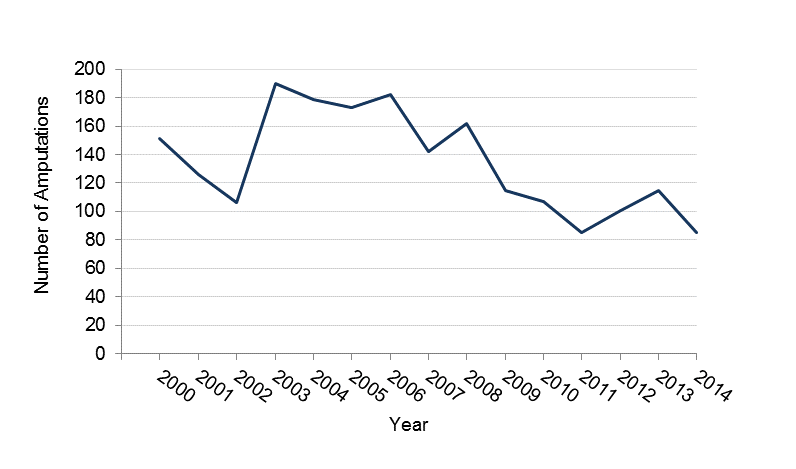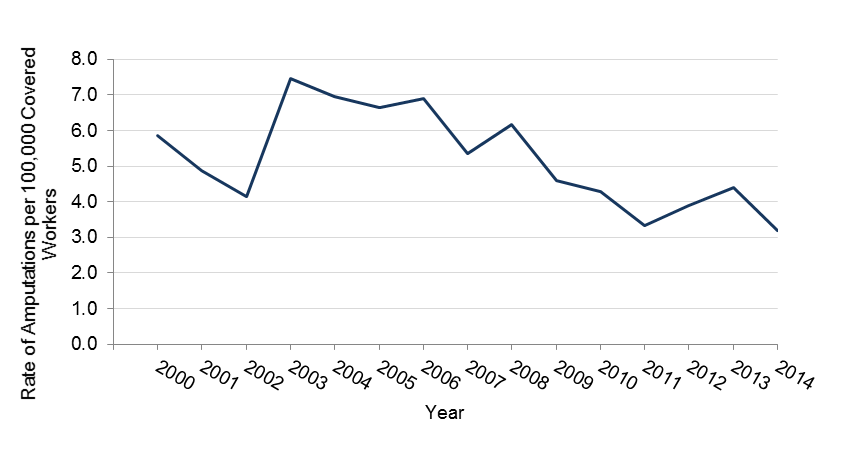Work-Related Amputations with Lost Work Time Involving Workers’ Compensation Claims
Amputations are preventable and debilitating injuries that lead to losses in productivity and income. Although work-related amputations, both fatal and non-fatal, occur less frequently than other work-related injuries, they are often more severe and impact both the worker and employer more profoundly.
Review of these injuries and tracking of these events can provide critical information for the development and improvement of prevention strategies and regulations to protect workers.
Two indicators measure the number of amputations that occur due to work-related activities: amputations reported by employers and amputations that involve workers’ compensation claims. While these two indicators measure similar outcomes, the data used to compile/create each indicator will produce different estimates of the number of amputations with lost work time. These differences are due in part to the methods in which data are collected and recorded. To obtain the best picture of the number of amputations with lost work time, both indicators are necessary.
The amputation indicator reported here utilizes Minnesota workers’ compensation claims data to characterize the numbers, rates, and trends of amputations. The Minnesota Department of Labor and Industry (DLI) collects and maintains the workers’ compensation dataset. DLI provides data to the Center for Occupational Health and Safety (COHS) at the Minnesota Department of Health (MDH) for the completion of this indicator. The Minnesota DLI research and statistics unit creates a number of reports and other informational products on workers’ compensation claims and the impact they have on Minnesota’s worker population.
In 2014 in Minnesota, there were 85 workers’ compensation claims for amputations, below the 2000-2014 average of 135 claims/year. The rate of amputation claims for 2014 was 3.2 claims per 100,000 workers.
These numbers can be compared to the numbers of amputations as reported by employers from the Survey of Occupational Injury and Illnesses, based on a probability sample of employers and their OSHA injury logs. While there is relatively little year-to-year correlation in the numbers (up to a two-fold difference in counts), the average number of cases per year over the period 2000-2014 for each of the amputation indicators is quite similar: 135 cases based on workers’ compensation claims versus 123 cases as estimated by the SOII. National estimates of the number of amputations reported through workers’ compensation are not readily available since workers’ compensation systems differ for each state. Also, comparison between states is not advised due to differences in eligibility and other worker’s compensation policies, differences in the mix of industries, and other factors.
Number and Rate of Amputation Cases with Lost Work-Time Filed with State Workers’ Compensation in Minnesota, 2000-2014
| Year | Number | Rate per 100,000 Workers |
| 2000 | 151 | 5.9 |
| 2001 | 126 | 4.9 |
| 2002 | 106 | 4.2 |
| 2003 | 190 | 7.5 |
| 2004 | 179 | 6.9 |
| 2005 | 173 | 6.6 |
| 2006 | 182 | 6.9 |
| 2007 | 142 | 5.4 |
| 2008 | 162 | 6.2 |
| 2009 | 115 | 4.6 |
| 2010 | 107 | 4.3 |
| 2011 | 85 | 3.3 |
| 2012 | 101 | 3.9 |
| 2013 | 115 | 4.4 |
| 2014 | 85 | 3.2 |
Number of Amputation Cases with lost work-time Filed with State Workers’ Compensation in Minnesota, 2000-2014

Incidence Rate of Amputation Cases with Lost Work-time Filed with State Workers’ Compensation per 100,000 Workers Covered by the Workers’ Compensation in Minnesota, 2000-2014

Trend analysis of both amputation indicators demonstrates a non-significant trend, neither increasing nor decreasing between 2000 and 2014. As this indicator makes use of workers’ compensation data there may be an undercount in the number of amputations counted. This may be due to underreporting by employees, physicians, or employers to their workers’ compensation insurer. Even though this indicator may not be a complete count of amputations, it does provide an understanding of the rates and trends of amputations that occur each year and the continued need for both surveillance and intervention programs to further reduce work-related amputations